Automate Expense Management in Four Steps
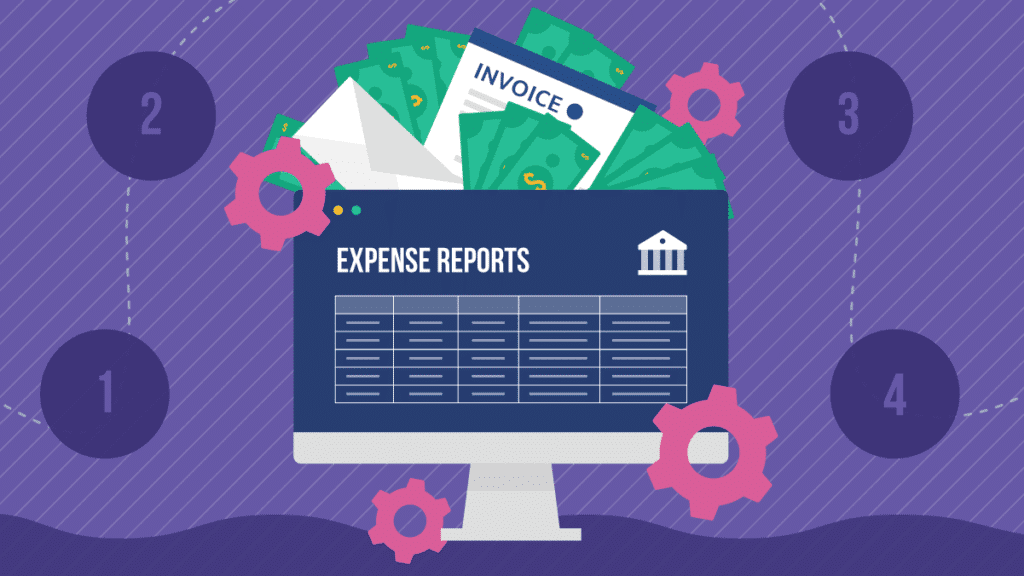
After payroll, travel expenses and employee spending are the second-largest controllable costs for businesses. Businesses spend a lot of money on expenses, which means they need to process a lot of receipts and invoices. In our 2021 Survey of AP teams, “AP Today: Bottlenecks, Benchmarks & Best Practices,” 54% of finance teams reported processing over 500 invoices each month. Of that number, 16% process over 5,000 invoices per month. For businesses using time-consuming manual processes, this can impose a significant and expensive workload.
You may already know that automating and streamlining your company’s expense management processes can save you time and money. You may not know that spend management automation can help you maximize ROI on business expenses. The right expense management software can provide you with the ability to collect, track, and analyze expenditure data in real-time. This capability lets you identify and mitigate risks, ensure compliance, and make wise spending decisions.
This article takes a deep dive into how to streamline and automate your expense management systems. In four simple steps you’ll learn how to:
- Document current expense processes and set goals
- Get buy-in from the CFO and key stakeholders
- Choose the right expense management software
- Implement and evaluate your solution
We’ll start by talking about some of the key benefits of automating your expense management processes.
Benefits of Expense Management Automation
Automating your expense management can result in significant benefits to your business through streamlining workflows, reducing errors, and providing accurate real-time expenditure data. Here are some of the specific benefits of automation:
Expense Management Software Reduces Costs and Risk
According to a 2019 survey of finance leaders, 72% of companies have a formal expense policy. However, the same study revealed that 43% of businesses process expense reports manually, and 46% don’t track the cost of doing so. Of businesses with an expense management process, only 27% have a system to identify and track expenses that aren’t allowed under their expense policy.
In another study, the Global Business Travel Association estimates that it takes 20 minutes for an average company to process one expense report at an average cost of $58 per report. In addition, 18% of expense reports contain errors, which take an average of 18 minutes per report to correct, at an average cost of $52 each. It’s not hard to see how expense management costs can spiral out of control as the number of expense reports (and the number of mistakes) increases.
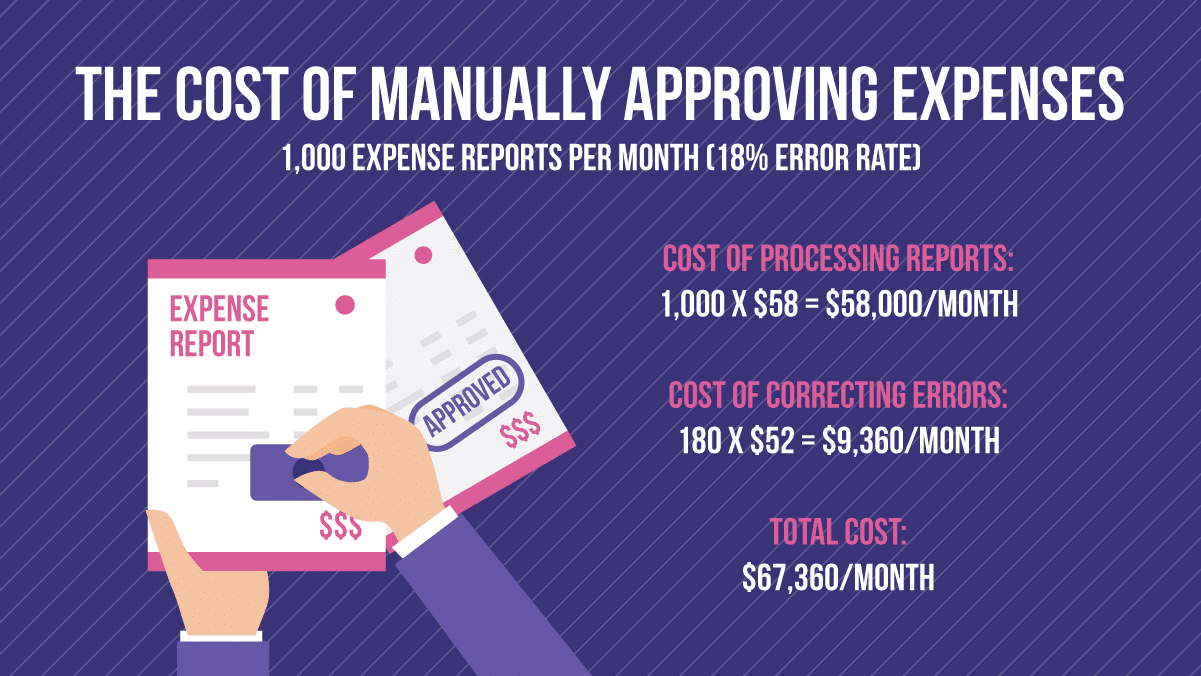
An automated system will significantly reduce the amount of time spent on each expense report, saving time and money. Automation also reduces errors in expense reports, which reduces costs even further and decreases the risk of missed errors.
Automated Expense Reporting Process Speeds Up Approval Process and Reimbursement
Expense management software reduces time and hassles for employees and approvers. Employees can use a mobile app to scan receipts and enter expense details quickly, and the software can also pull expenditure information from corporate cards. Once the expense report has been entered, the system automatically sends it to the approver. After the report is approved, it automatically goes to your AP team for payment processing.
Adding payment cards (Pcards) or virtual cards to your expense management system can make this process even faster and more secure. Pcards can be assigned to individual employees, and expenses can be tracked and approved in real-time.
Expense Data Entry, Tracking, and Centralization Provides Transparency and Accountability
Manual expense management processes can leave finance teams in the dark about how much money a business is spending. Expense management software captures, tracks, and centralizes expense data in real-time to report exactly where your company’s money is going. You can analyze this data to gain insights into expense policy compliance and spending patterns, detect errors and fraud, and forecast future spending.
Automation Increases Expense Policy Compliance and Reduces Expense Fraud
An automated expense management system lets you combine departmental expense policies into a single, company-wide policy. The software can also enforce your expense policy in real-time by denying or flagging disallowed expense submissions.
Real-time expense data tracking and analysis tools also help prevent fraud by detecting and reporting suspicious spending patterns and fraudulent expenses. For example, the software can detect an employee sending duplicate expense claims for the same expense and flag the expenses for review.
Real-Time Visibility of Expense Data Supports Business Growth
Your business needs positive cash flow to grow. By providing accurate expense data in real-time, expense management software lets you see exactly how much money your business has on hand. You can not only anticipate and plan for future expenses, but you can allocate funds to investments in new opportunities.
Now that you know the key benefits of automating expense management, it’s time to look at how to automate your company’s expense management processes. We’ve broken the task into four main steps to make things a little easier to follow:
Step 1: Document Current Expense Processes and Set Goals
The first step to automating your expense management system is to look at how your business manages expenses and decide what you’d like to improve. You can break this process down into six activities.
Understand Existing Expense Policies and Processes
Begin by tracking down and documenting expense policies to understand how you currently manage expenses. Be sure to include informal expense policies such as petty cash. At the same time, map out your expense management processes to better understand workflows, including:
- Details on corporate credit cards or payment cards
- How paper expense documents are processed and archived
- Who can approve expenses and what expenses they can approve
- Integration with other business processes such as ERP and accounting systems
Review the procedures with your team, and update the procedures as needed.
Gather, Clean, and Centralize Expense Data
Gather and centralize your current expenses data to make it easier to migrate the data into your expense management software. Store it in a spreadsheet or centralized database as you gather the data. Once you’ve collected all the data, validate it for errors such as duplicate entries.
Set Expense Management Goals
Defining the goals you want to achieve by automating expense management will help you set priorities and build your expense management strategy. It will also help you decide which expense management software you need. Analyze your current expense policies and data to identify areas where you’d like to make improvements or streamline workflows.
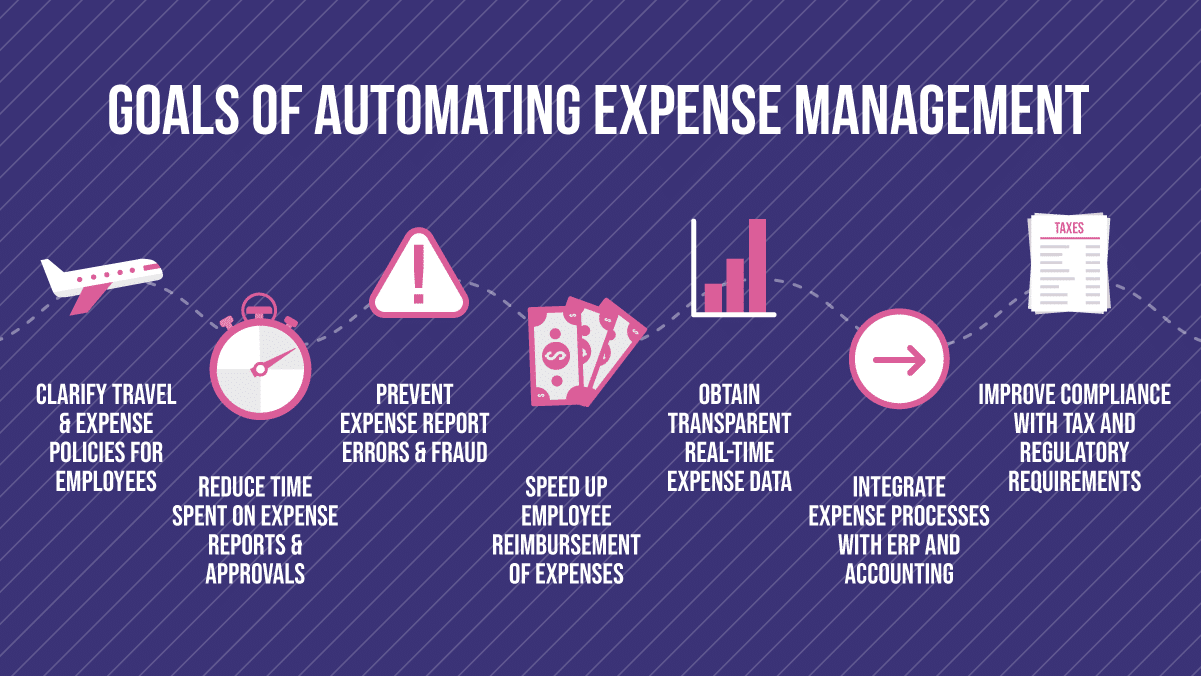
Understand Your Technology and Feature Needs
Look at your current expense processes and business systems and determine your technology and feature needs.
Your technology needs could include:
● Scalability to handle an increase in expense reports
● Cloud solutions to cover remote workers or multiple locations
● Integration with accounting software and ERP platforms; and
● Compatibility with devices and operating systems.
Different expense management software platforms offer various features. Common features include:
● OCR and machine learning technology to enter paper receipts and invoices
● Compliance with security, tax, and privacy regulations
● Automatic mileage and per diem calculations
● Mobile apps or offline mode; and
● Virtual payment cards.
Determine a Budget
To determine your budget for purchasing expense management software, you need to estimate automation’s impact on your bottom line. Begin by assessing the potential cost savings from automating your expense management processes using this simple formula:
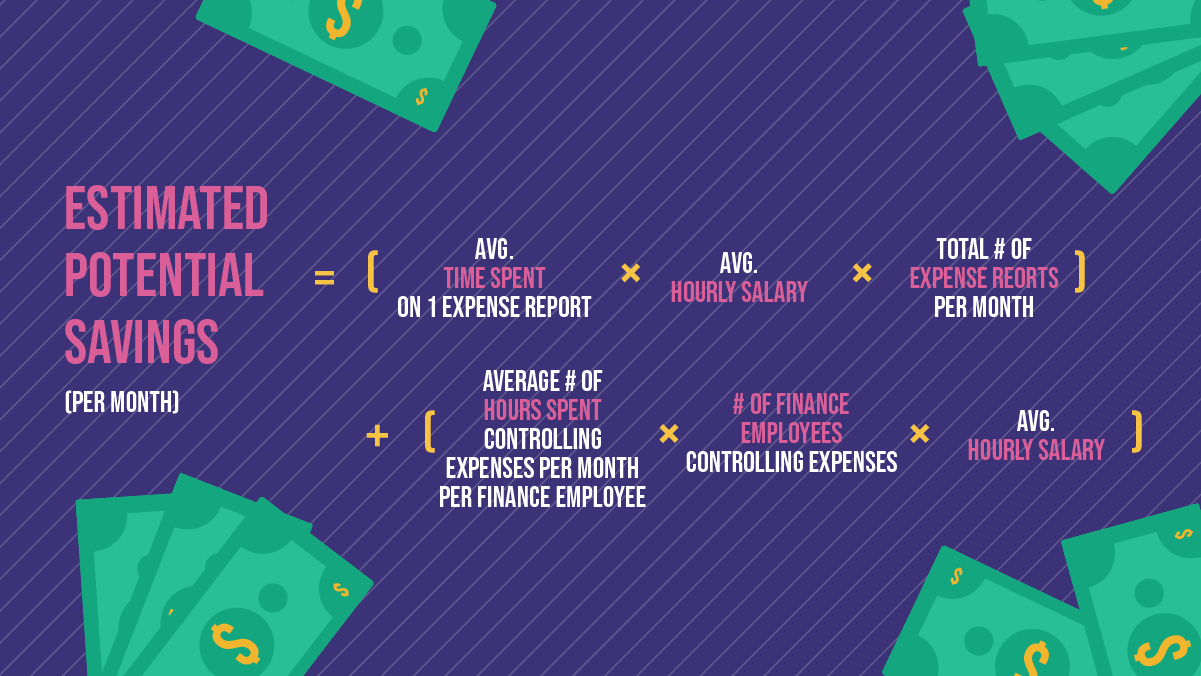
You can use this cost savings estimate and the pricing for different expense management platforms to calculate a rough estimate of the ROI for automation. You can refine your estimate by estimating or modeling the indirect costs savings from automation. These include reduced fraud and errors, streamlined processes, better cash flow, and more money to invest in opportunities. You can also consider future factors such as business growth and expected increases in the number of expense reports.
Engage Key Stakeholders
Automating your expense processes will affect everyone in your organization, so you’ll need buy-in and input from key stakeholders for your implementation to succeed. Engage your IT, finance, accounting, and HR teams early in the process. These teams will be able to provide valuable input on their expense workflows, and they will offer insights into what’s working and what needs to be changed.
- Finance and Accounting Teams are usually responsible for expense management policies and processes, approval processes, entering expenses into the company books, and analyzing and forecasting expense data. Automation would help them streamline existing processes and provide accurate real-time expense data.
- HR is usually responsible for reimbursing employees for expenses and managing employee wellbeing. Automation would simplify their job by simplifying expense reports and reducing frustrating delays in reimbursement.
- IT is responsible for implementing and maintaining the expense management software and integrating it with other business software platforms. They would see benefits from low-maintenance and flexible solutions that are easily scalable, secure, and facilitate integration.
In addition to engaging key stakeholders, you will need buy-in from company leaders to authorize purchasing expensive management software and to automate expense management processes. You’ll also need to ensure that employees adopt the new expense management system – after all, they’re the ones who have to use it every day.
Step 2 – Get Buy-In From Management
You will have a solid business case for automating expense management processes in your company by now. The next step is to get buy-in from your executives to purchase and implement a solution.
In most companies, the CFO is responsible for evaluating the business case for expense process automation and bringing it forward to the executive management for approval. That means the business case needs to support the company’s core strategy and mission. These will vary from company to company, but in general, executives are concerned with three goals:
● Keeping costs down and growing the bottom line
● Executing the company’s mission
● Doing what’s best for their people
To get buy-in from senior management, ensure that the business plan for automation provides concrete evidence on how it will help them pursue these three goals. For example, you could use cost savings and ROI estimates to demonstrate how automation will grow the bottom line. You could also show how streamlining expense reports and approval processes saves time and reduces frustration for employees and approvers. Finally, you could explain how automation increases cash flow, which provides the company with money it can invest in new opportunities and execute its mission.
Step 3 – Choose the Right Expense Management Software
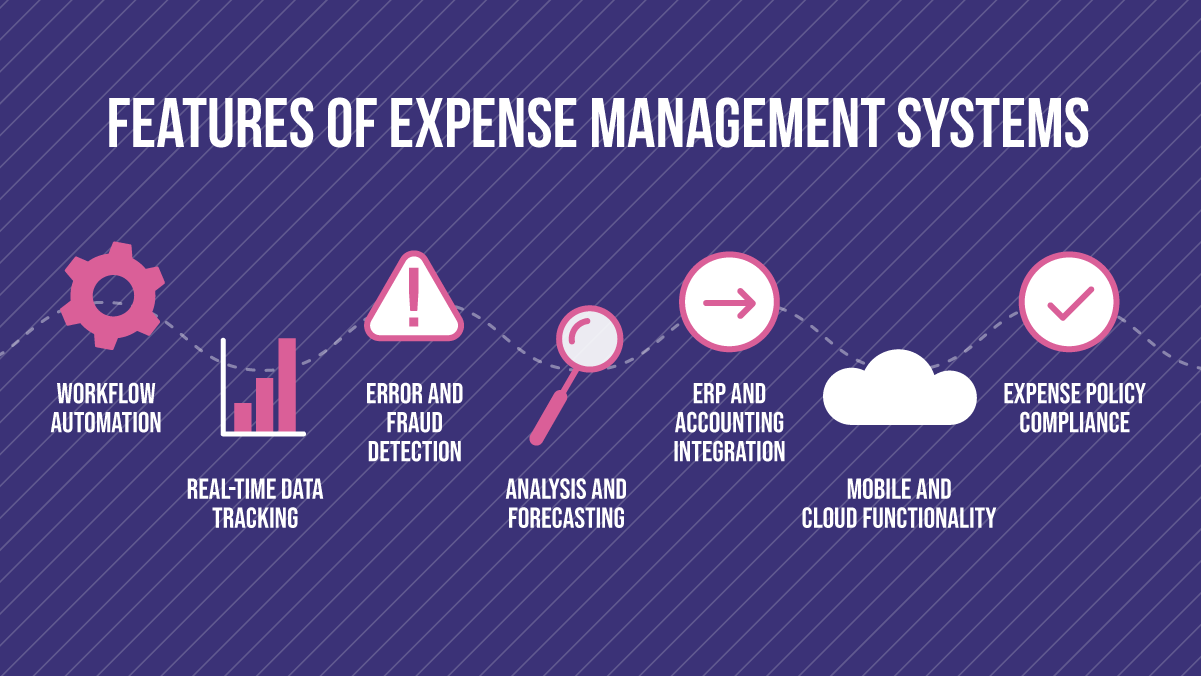
Once you’ve got a clear understanding of your current processes and goals for expense management and buy-in from stakeholders and senior management, you can look at expense management solutions. The right solution needs to be cost-effective, scalable, and powerful enough to meet your expense management needs. The solution also needs to be flexible and adaptable when your needs change.
You can choose a single all-in-one solution that handles every aspect of your expense management processes or use a combination of task-specific tools. Begin by reviewing your expense management needs and how automation can address them.
Features of Expense Management Systems
Here are some of the key features and capabilities you should consider when looking for an expense management solution:
- Workflow Automation: Automate document entry, expense reporting, and approval processes to reduce data entry and expense processing time.
- Real-Time Data Tracking: Track and report purchases, credit card usage, expense reports, approvals, and reimbursements to give visibility and control of expenses.
- Error and Fraud Detection: Automatically detect and report errors and fraud to manage and mitigate risks and reduce costs.
- Analysis and Forecasting: Reveal spending patterns, identify cost savings opportunities, and anticipate future costs to inform decision making and planning.
- ERP and Accounting Integration: Transfer data and handoff processes to other business systems to increase efficiency and reduce costs.
- Mobile and Cloud Functionality: Allow expense reporting, approvals, and analysis from anywhere globally.
- Expense Policy Compliance: Enforce spending limits, block disallowed expenses, pre-populate per-diems, and control card use to prevent shadow spend.
Once you have a good idea of your needs and which features and capabilities you’d like, you can start evaluating different expense management software platforms.
How to Select the Right Expense Management Software Platform
Start by researching the various expense management software platforms and determine which systems offer the capabilities you need. Then score each solution’s capabilities against your list of criteria to build a shortlist of vendors who are a good fit for your needs.
Engage the shortlisted vendors to discuss your needs and refine your understanding of each vendor’s capabilities and pricing. Compare each platform’s features, pricing, and user reviews to refine your criteria further and evaluate the vendors on your shortlist.
Two or three vendors should emerge as a potentially good fit for your business at this stage. Invite each of these vendors to provide a proposal to automate your expense management processes. Forward the proposals and your recommendations to the stakeholders within your company and ask for their opinion.
Ask one or more vendors to provide a demo or a free trial to allow stakeholders to test drive each solution. Choose the vendor that has the best combination of pricing, capabilities, and fit for your business.
Once you’ve chosen and engaged a vendor, you need to implement the expense management solution at your company.
Step 4: Implementing and Evaluating Expense Management Software
Preparation is essential for a smooth and successful implementation. Before you do anything else, hold a kickoff meeting with your stakeholders and vendor representatives to ensure everyone is on the same page on what needs to be done and when. Holding a kickoff meeting will let you build a detailed implementation work plan and schedule to keep everything on track. Your vendor will be a great resource at this stage, as they can draw on their experience with other successful implementations to provide guidance and advice.
The actual implementation plan will depend on the size of your company and the complexity of your needs. Here are some pointers to make the process a little easier:
- Ensure good communication by holding regular implementation meetings and providing a central place for the implementation team to communicate and share information.
- Get employees on board early to ensure a high adoption rate when the expense management system is running. You can show employees how the system will make their jobs easier.
- Document everything to keep track of important information. It’s easy for information to get lost during projects. Assign a team member to gather and centralize specifications, guides, expense policies, and other key documents.
- Prepare evaluation criteria to measure the performance and effectiveness of the expense management system once it is operational to help you identify and address problems with the vendor.
Once your expense management system is operational, schedule regular meetings with your vendor to review and address performance issues and information on new features and capabilities.
Automate Expense Management With Stampli
Stampli provides a cloud-based expense automation platform that processes expenses faster, cheaper, and more efficiently. Here’s how Stampli can help you automate your expense management processes.
Stampli Card – Take Control of Expenses
Stampli Card accelerates the expense reporting and approval process. Your business can print personalized payment cards to track and control employee spending for each transaction. Stampli Cards prevent shadow spend and fraud because they are assigned to authorized users with preset spending limits. Plus, the cards can be restricted to spending categories for each employee.
Expense Process Automation – Real-Time Approval Process Visibility
Stampli Card is part of Stampli’s innovative, AI-driven approach to accounts payable automation. The Stampli platform lets you automate and streamline the entire expense cycle. From the moment an expense is incurred, our platform gives you visibility and control over every step of the process.
Get a free demo of Stampli and learn how to automate your expense management processes quickly and effectively.
